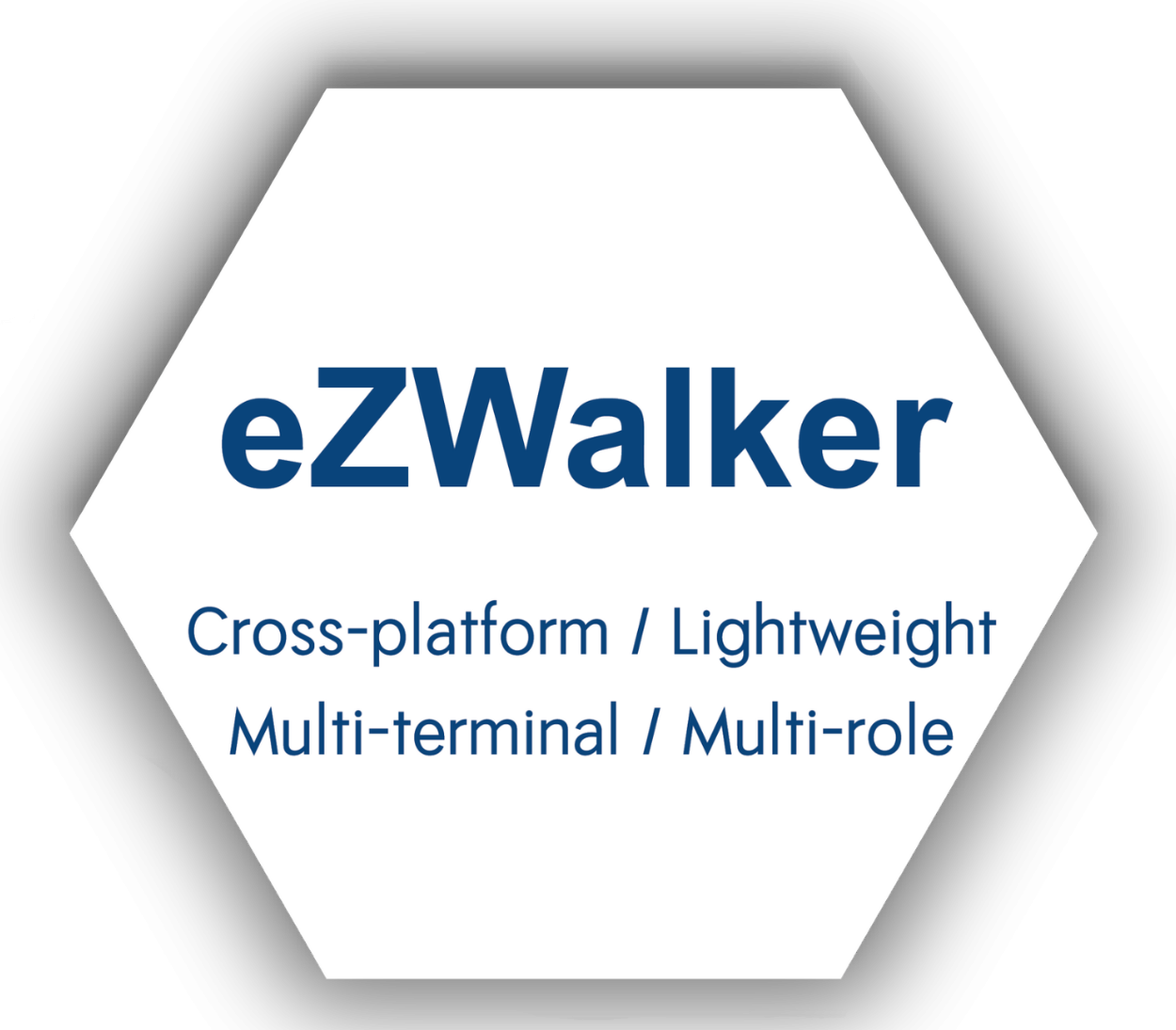 |
Design elements included in the program
Eurocode 0, Basis of structural design
Basic design principles and verification equations
Partial safety factors
Load combinations
Material factors
EN 1990:2002/A1:2005/AC:2010
Eurocode – Basis of structural design |
 |
Eurocode 1, Actions on structures
General action
Category of use
Imposed loads on building parts
Snow loads
Wind Loads
EN 1991-1-1:2002/AC:2009
Eurocode 1: Actions on structures – Part 1-1: General actions – Densities, self-weight, imposed loads for buildings |
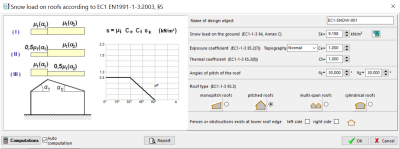 |
Snow loads
Snow load on the ground
Snow load on roofs
Snow load on snow guards
Snow overhanging the edge of the roofEN 1991-1-3:2003/A1:2015
Eurocode 1 – Actions on structures – Part 1-3: General actions – Snow loads |
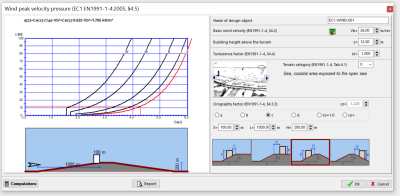 |
Wind loads
Wind velocity pressure
Wind pressure on vertical walls
Wind pressure on flat roofs
Wind pressure on monopitch roofs
Wind pressure on duopitch roofs
EN 1991-1-4:2005/A1:2010 /AC:2010
Eurocode 1: Actions on structures – Part 1-4: General actions – Wind actions |
 |
Eurocode 2, Design of concrete structures
EN 1992-1-1:2004/A1:2014
Eurocode 2: Design of concrete structures – Part 1-1: General rules and rules for buildings |
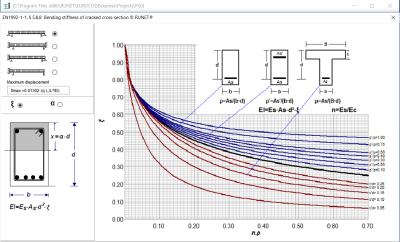 |
Design charts of Reinforced concrete
Concrete-steel properties, creep, shrinkage, concrete cover
Section capacity in bending, shear and axial loading
Design charts for bending
Design charts for columns in single and double bending
Effective length of columns
Design charts for deflection control |
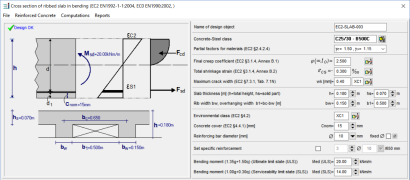 |
Reinforced concrete slabs
Slab sections in bending
Ribbed slab sections in bending
Flat slab sections punching shear
Slab sections in bending
Lightweight concrete
One way continuous slabs
Cantilever slabs
Two way slabs |
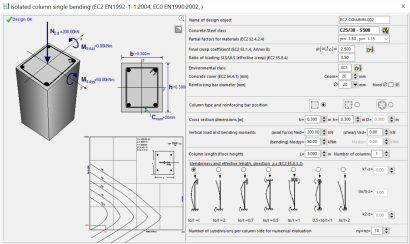 |
Reinforced concrete beams
Rectangular beam cross-section in bending
T beam cross-section in bending
Beam cross-section in torsion
Beam cross-section, lightweight concrete
T beam cross-section, lightweight concrete
One span beams in composite loading
Continuous beams with distributed loads
Reinforced concrete columns
Column section in biaxial bending
Isolated column in simple bending
Isolated column in double bending
Column strength (single eccentricity) |
 |
Eurocode 3 – Structural steel
EN 1993-1-1:2005/AC:2009
Eurocode 3: Design of steel structures – Part 1-1: General rules and rules for buildings
EN 1993-1-3:2006/AC:2009
Eurocode 3 – Design of steel structures – Part 1-3: General rules – Supplementary rules for cold-formed members and sheeting
EN 1993-1-5:2006/AC:2009 /A1:2017
Eurocode 3 – Design of steel structures – Part 1-5: Plated structural elements
EN 1993-1-6:2007/AC:2009/A1:2017
Eurocode 3 – Design of steel structures – Part 1-6: Strength and Stability of Shell Structures
EN 1993-1-7:2007/AC:2009
Eurocode 3 – Design of steel structures – Part 1-7: Plated structures subject to out-of-plane loading
EN 1993-1-8:2005/AC:2009
Eurocode 3: Design of steel structures – Part 1-8: Design of joints |
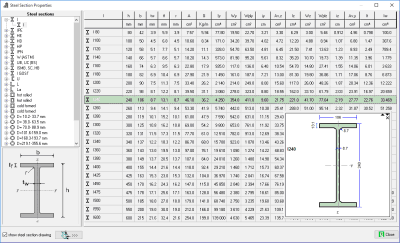 |
Tables and graphs from Eurocode 3
Flexural buckling
Lateral torsional buckling
Effective length of columns
Steel sections
Steel section properties, all international profiles
Classification and resistance of steel cross sections
|
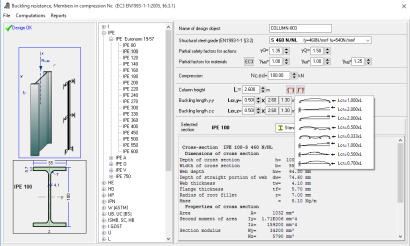 |
Resistance of steel cross-section
Single actions
Double actions
Combined actionsBuckling resistance
Buckling, members in compression Nc
Buckling, compression, bending Nc-My-MzLateral torsional buckling My
Lateral torsional buckling Nc-My |
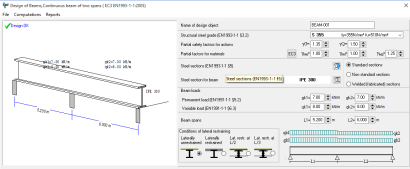 |
Design of beams
One span beams
Two-span continuous beams
One span with a cantilever |
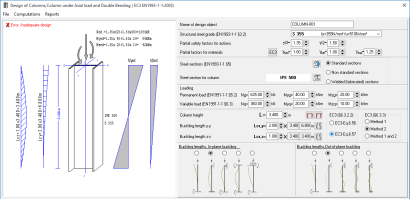 |
Design of columns
Column under axial load
Column under axial load and bending
Column under axial load and double bending |
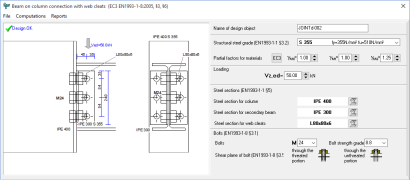 |
Design of bolted connections
Double shear joints
Beam-to-beam connection with web cleats
Beam-to-column connection with end plate
Simple column base connection |
 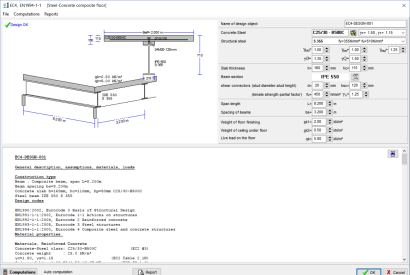 |
Eurocode 4,
Design of composite steel and concrete structures
Steel-Concrete composite floor
Timber concrete composite floors
EN 1994-1-1:2004
Design of composite steel and concrete structures, General rules and rules for buildings
|
|
|
 |
Eurocode 5, Design of timber structures
|
Design of cross-sections in Ultimate limit state |
|
Design of timber connections |
|
Design of timber beams |
|
Design of timber floors |
|
Design of timber roofs
|
EN 1995-1-1:2003 Design of timber structures – General – Common rules and rules for buildings
EN 1995-1-2:2003 Design of timber structures – General – Structural fire design |
 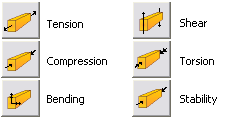 |
Design of cross-sections in Ultimate limit state
Tension
Compression
Bending
Shear
Torsion
Stability
Design of various cases of single or combined action according to Eurocode 5, EN 1995-1-1:2004 § 6, round and rectangular sections. |
 |
Design of timber connections
The Capacity Rd is computed according to Eurocode 5, EN 1995-1-1:2004 § 8. |
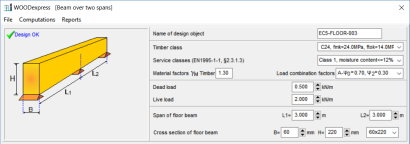 |
Design of timber beams
Simply supported
Continuous over two spans |
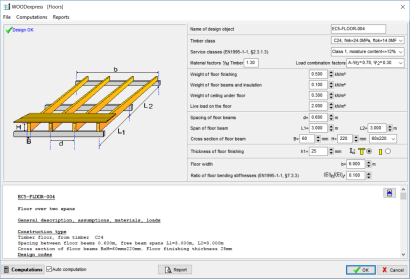 |
Design of floors
Design of single-span floors
Design of two-span floors
The internal forces are computed at the ends and the middle span of the floor beam and the elastic bending deformations at midspan for all the load combinations according to Eurocode 0, 1, and 5.
All the checks of Eurocode 5, EN 1995-1-1:2004, § 6 are performed in the ultimate limit state.
The deflections are checked in the serviceability limit state according to Eurocode EN 1995-1-1:2004, § 7.
The Eurocode EN 1995-1-1:2004, § 7.3. considerations are taken into account for the check of beam vibrations. |
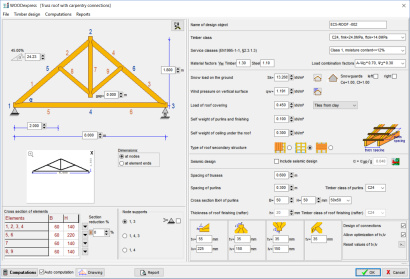 |
Design of Roofs
Truss rafter roofs
Truss rafter roofs, carpentry connections
Collar roofs
Monopitch roofs
The design is based on a finite element analysis of the truss structure. The truss is considered a two-dimensional frame structure, and the stiffness of the connections is adjusted according to the selected degree of stiffness. The natural frequencies of the roof trusses are computed from a dynamic analysis. |
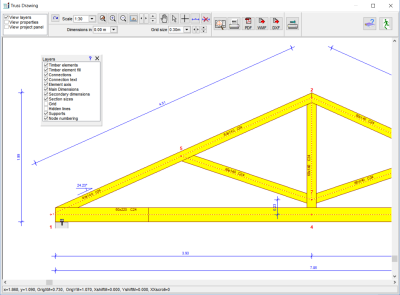 |
Automatic generation of truss drawings.
Detailed drawings of the truss structure and the connections are automatically produced. A specialized CAD modulus is included to customize, preview and print the drawings. Export to DXF and PDF files.
Structural fire design
Structural fire design is performed for every stress case. The structural fire design is performed according to Eurocode 5, part 1-2, reduced cross section method.
Connections properties you can specify are steel plate type, regular or BMF, plate thickness, the degree of stiffness of connections, and the type and size of the connection nails.
You can also select to use single or multiple plates with more than two members in the joints.
Splices are designed automatically for long timber members. |
|
|
 |
Eurocode 6, Design of masonry structures
|
Mechanical Properties of masonry |
|
Eurocode 6 design charts |
|
Eurocode 6 Strength |
|
Masonry Design
|
Eurocode 6 EN 1996-1-1:2005 Design of masonry structures, General rules for reinforced and unreinforced masonry structures |
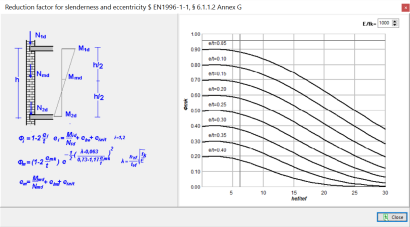 |
Mechanical Properties of masonry
Material factors
Compressive strength
Shear strength
Flexural strength |
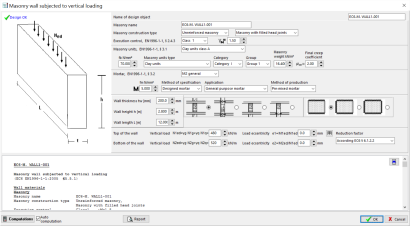 |
Eurocode 6 design charts
Out-of-plane eccentricity
Reduction factor for slenderness and eccentricity
Bending moment coefficients for flexural design
Eurocode 6 Strength
Compressive strength
Shear strength
Flexural strength |
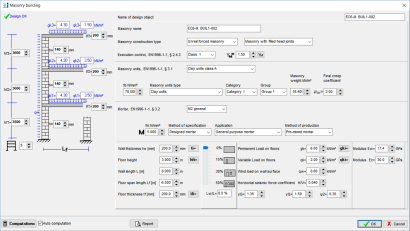 |
Masonry Design
Masonry subjected to vertical load
Masonry subjected to shear load
Masonry subjected to lateral load
Masonry building design |
|
|
 |
Eurocode 7, Geotechnical design
|
Eurocode 7 parameters |
|
Soil bearing capacity |
|
Spread footings |
|
Retaining walls |
EN 1997-1:2004/AC:2009
Eurocode 7: Geotechnical design – Part 1: General rules |
 |
Soil bearing capacity
Drained conditions
Undrained conditionsThe design bearing resistance is calculated using analytical methods of Annex D in Eurocode 7. |
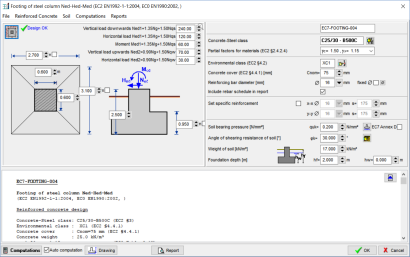 |
Spread footings
Flexible centrically loaded footings
Flexible eccentrically loaded footings
Footings of steel columns (pinned)
Footings of steel columns (fixed)Vertical loading and moments at the top.Exact computation of pressure distribution under the footing. Geotechnical design using Eurocode 7, EN 1997-1:2004. Load combinations according to Eurocode 7 (EQU, STR, GEO load cases). |
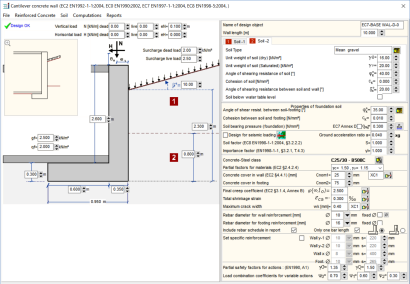 |
Retaining walls
Cantilever type without back heel
Cantilever type with back heel
Basement walls
Earth pressure coefficients (active and passive)
- Walls with very small back heel. The active earth pressure is computed using Coulomb’s theory at the back face of the wall.
- Walls with back heel. The active earth pressure is computed using Rankine’s theory at a vertical surface at the end of the heel.
- Basement walls. Earth pressure at rest.
Earthquake analysis according to Eurocode 8 (EC8), Mononobe-Okabe. |
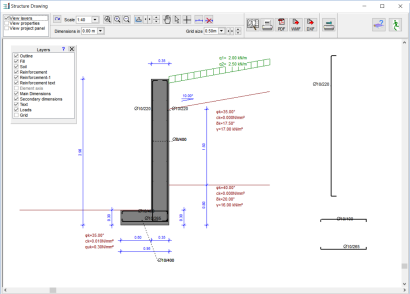 |
CAD drawing of retaining walls with reinforcement. |
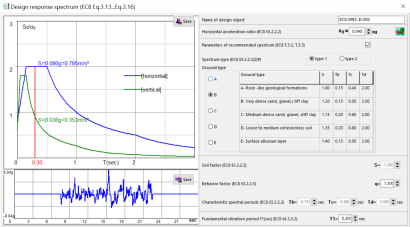 |
Eurocode 8,
Design of structures for earthquake resistance
Elastic response spectrum
Design response spectrum
EN 1998-1:2004/A1:2013/AC:2009Eurocode 8: Design of structures for earthquake resistance – Part 1: General rules, seismic actions, and rules for buildings |
 |
Structural analysis
Helpful tables for structural analysis
Beams of one span
Moments of intertia of common cross sections
Tables for Beams diagrams V (shear) M, (moment)
Tables for Beams diagrams V (unit load)
Tables for end forces of beams (Cross method)
Tables for beams deflections
Tables for areas and centroids of diagrams
Tables of Mohr’s integral |
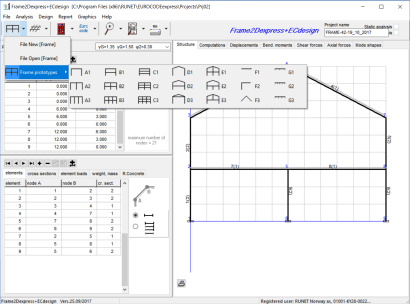 |
FRAME2D Design
The EUROCODEexpress includes a program for Design of 2-dimensional Frame structures and grillages.
A 2-dimensional finite element model, with additional design in the ultimate limit state of the members from reinforced concrete, structural steel, or structural timber, according to Eurocodes 2,3 or 5. |

